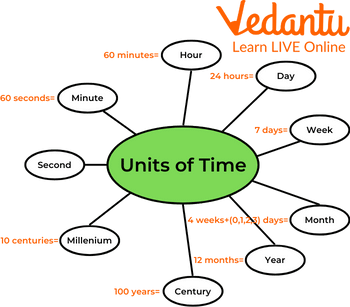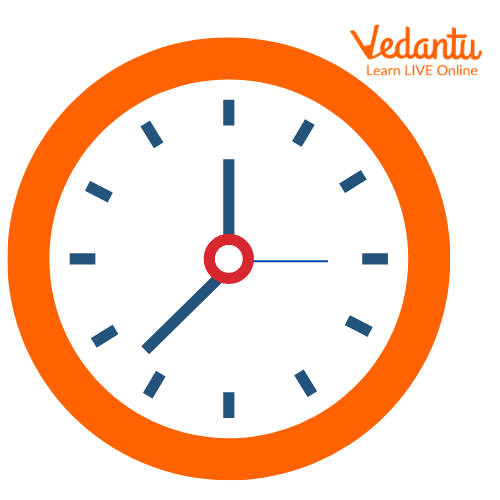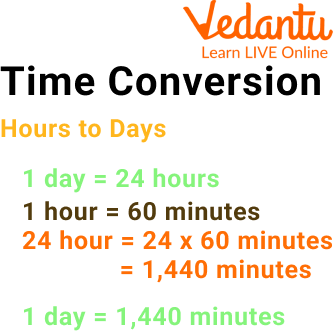




How to Convert Between Different Units of Time
Everywhere in the world, time is measured using the same system. What exactly is that? How many seconds in a day? What is the SI unit of time? Well, you can see for yourself if you simply look at a watch or a clock. Do you see anything? Minutes and hours are displayed. What else do you notice? Also visible are seconds.
Since they are used to measure time, they are referred to as units of time. The seconds hand travels the fastest, followed by the minute and hour arms if you take some time to observe an extremely old clock with moving arms. Your clock will only display 60 seconds and 60 minutes, as you will also observe.

Units of Time
For hours, just 12 are displayed. When converting between your time units of hours, minutes, and seconds, you must take into account how different the time system operates.
Knowing the Units of Time

Units of Time
The more typical time units are first displayed in the form of a concept web, going from the smallest unit to the largest unit. Start with a second, then move on to a minute, and so on.
The fundamental units of time that we are familiar with are the second, minute, hour, day, week, month, year, century, and millennium. The concept web's second unit is the smallest. We mostly use seconds, minutes, hours, days, weeks, months, and years to measure time:
SI Unit of Time

Measuring Instruments
The second, which is often known as the SI unit of time, is more precisely described as "the time interval equal to 9192631770 periods of the radiation corresponding to the transition between the two hyperfine levels of the ground state of the cesium-133 atom". Whatever the case, the unit second is sometimes written as s or sec.
Smallest Unit of Time

Smallest Unit of Time
The smallest unit of time is the second. The base unit of time in the SI unit is second. The following can be used to express all other time units in terms of seconds:
1 minute = 60 s
1 hour = 3600 s and so on.
So, how many seconds in a day?
There are 60 seconds in a minute, 60 minutes in an hour, and 24 hours in a day. There are 86,400 seconds in a day because $60 \times 60 \times 24$.
Minutes and Hours to Days Conversion

Hours and Minutes to Days Conversion
Divide the time by the conversion ratio to convert a measurement of an hour to a measurement of a day.
Since 24 hours make up one day, you can convert using the following easy formula:
days = hours ÷ 24
Hours are converted to days by dividing by 24.
For illustration, use the formula above to convert 5 hours to days.
5 hr = (5 ÷ 24) = 0.208333 days
If we want to convert minutes in a day then again we have to divide by 60.
A few units used to measure time are hours, minutes and days.
Solved Example
1. Convert the following:
i) 7 days 6 hours into hours.
Ans: 1 day = 24 hours
$\text { Therefore, } 7 \text { days } 6 \text { hours } =(7 \times 24) \text { hours }+6 \text { hours }$
$=168 \text { hours }+6 \text { hours }$
$=174 \text { hours }$
ii) 5 years 9 months into months.
Ans: 1 year =12 months
$\text { Therefore, } 5 \text { years } 9 \text { months } =(5 \times 12) \text { months }+9 \text { months }$
$=(60+9) \text { months }=69 \text { months }$
Practice Problem
1. Convert the following:
i) 6 hours 40 minutes into minutes.
Ans: 400 minutes
ii) 4 minutes 25 seconds into seconds.
Ans: 265 seconds
Summary
The duration of events or the gaps between them can be measured, compared, or even ordered using time. Units must be specified to measure time; however, there are many possible time units, some of which may be more suitable than others depending on the situation.
Outside of strictly scientific purposes, other units are usually applied for longer durations.
Minute (60 seconds)
Hour (60 minutes, or 3,600 seconds)
Day (24 hours, or 86,400 seconds)
Week (7 days, or 604,800 seconds)
Month (28-31 days, or 2,419,200-2,678.400 seconds)
Year (about 365.25 days, or about 31,557,600 seconds)
FAQs on Units of Time: Key Concepts & Formulas
1. What are the main units of time?
The main units of time include the second, minute, hour, day, week, month, and year. These units help measure and describe the passage of time, from very short durations to longer periods in daily life and science.
2. How many seconds are there in one hour?
There are 3,600 seconds in one hour. This is calculated because there are 60 seconds in a minute and 60 minutes in an hour, so the formula is: $60 \times 60 = 3,600$ seconds in an hour.
3. What is the standard unit of time in the International System of Units (SI)?
The International System of Units (SI) uses the second as its basic unit of time. All other time measurements, such as minutes and hours, are based on the second in scientific calculations and timekeeping systems.
4. How can you convert minutes to seconds?
To convert minutes to seconds, multiply the number of minutes by 60. The formula is: $\text{Seconds} = \text{Minutes} \times 60$. For example, 5 minutes equals $5 \times 60 = 300$ seconds.
5. What are some larger units of time than a year?
Larger units of time than a year include:
- Decade (10 years)
- Century (100 years)
- Millennium (1,000 years)
6. Why do we use different units of time?
We use different units of time to measure events ranging from a split second to thousands of years. This helps us organize our day, schedule activities, and keep track of historical and scientific events accurately and efficiently.
7. How many hours are in a day and why?
There are 24 hours in a day. This division is based on the Earth's rotation, as it takes about 24 hours for the planet to complete one full turn, creating day and night cycles.
8. What is the relationship between a month and a year?
A year usually contains 12 months. These months are based on the Earth's orbit around the Sun, with one year representing a full orbit. Each month roughly corresponds to one cycle of the Moon's phases.
9. Can you list some unusual or lesser-known units of time?
Some unusual units of time are:
- Fortnight (14 days)
- Leap year (366 days)
- Nanosecond ($10^{-9}$ seconds)
10. How is time measured in scientific experiments?
In scientific experiments, time is often measured in seconds for accuracy. Devices like timers, clocks, or stopwatches measure time, and sometimes even smaller units, such as milliseconds or microseconds, are used for very precise measurements.
11. What are the smallest units of time used in physics?
The smallest units of time in physics include the nanosecond ($10^{-9}$ seconds), picosecond ($10^{-12}$ seconds), and femtosecond ($10^{-15}$ seconds). These units are essential for measuring extremely fast events, such as chemical reactions or atomic changes.

















